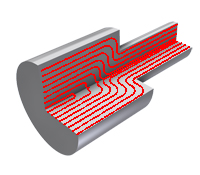Forged Hydraulic Cylinder Components

What is the process of Forging ?
Forging is the process of working or forming metal
to the desired shape by impact or pressure from hammers, presses or
forging machines. The metal object produced through this process is
termed a forging.
Forging Advantages ?
Forgings are superior over castings and fabrications
as the structural integrity can withstand the higher forces that exist
in a rigorous or high duty cycle application.
Why Choose Forging ?
Forgings are best used in high duty cycle or more
rigorous applications where a more durable, high quality hydraulic
cylinder is required. This could be within markets such as construction,
mining, refuse etc. Forged hydraulic cylinder components provide the
best impact resistance due to the improved directional strength of
the grain structure created through the forging process. Forgings
can also reduce cost in material, machining and even warranty due
to it's superior quality.
Forging Provides:
-
1
STRUCTURAL STRENGTH
Forgings provide exceptional structural integrity which in turn will ensure the component will withstand and exceed the application requirements. This reliability will reduce warranty claims and promote safety. -
2
DIRECTIONAL GRAIN FLOW
A forged component such as a hydraulic cylinder rod, trunnion, etc. produces a directional grain flow that improves the mechanical properties of the metal. The process will produce a predictable grain flow that will result in improved mechanical properties best suited to match the intended application. -
3
IMPACT STRENGTH AND FATIGUE RESISTANCE
This directional grain flow assures maximum impact resistance and fatigue, this will extend the service life of the component and the efficiency of the application. -
4
MANUFACTURING EFFICIENCY
In many cases forged hydraulic cylinder components are formed closer to the finished sizes in comparison to fabricated metal components, plate or barstock. This potentially reduces machining time and increases manufacturing efficiencies. -
5
REDUCED REJECTION RATES
Forged hydraulic cylinder components are weld free. The higher quality of the material and one piece construction improves upon the structural integrity which reduces reject costs and warranty claims.
A Forged component in a hydraulic cylinder could be any of the following:

Hydraulic Cylinders Rod

End Cap Assembly

Barrel Or Tube

Piston

Gland

Clevis

Trunnion

Flange
Forged Hydraulic Cylinder Components Provide:
- Excellent metallurgical properties, very consistent results
- Directional grain flow and superior strength
- Improved structural integrity and product reliability
- The elimination of welding results in a much stronger cylinder rod or component
- Heat treatment requirements will provide improved and more stable results
- Manufacturing requirements are simplified
- Reject, rework and replacement costs are greatly reduced
- Reduced warranty cost, improved warranty



